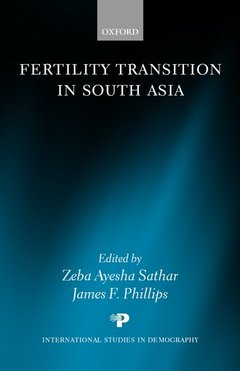Fertility Transition in South Asia International Studies in Demography Series
Langue : Anglais
Coordonnateurs : Sathar Zeba Ayesha, Phillips James F.

This compendium of nineteen chapters, written by South Asia scholars and international authorities in the field of population, provides an overview of a range of issues surrounding fertility change in South Asia over the past decade. In the first section of the book, the latest levels and trends in fertility in individual countries are covered. The quality of data is compared and discussed with the aim of clarifying fertility trends in the region as a whole. The section provides an authoritative data source for those interested in pursuing demographic analyses for South Asia as it enters the twenty-first century. The second section presents explanations for the contrasting onset, pace, and differentials in fertility declines experienced by countries in the region. Authors examine a range of alternative explanatory factors, emphasizing issues such as the causal role of gender systems, son preference, linguistic and regional boundaries, and development levels. The viewpoints presented here provide a range of competing theories on the South Asia fertility transition, which will be of particular value to sociologists, historians, and all those interested in comparative research for the region. The concluding section examines the role of policies in the South Asia fertility transition. Policies designed to reduce fertility were developed and launched in this region long before other regions in the world. In particular, family planning programmes were initiated in South Asia. In these final chapters, authors review the outcome of experiments conducted in settings where demand for family planning was constrained by pro-natalist social institutions, and where services were supplied to test the capacity of programmes to foster reproductive change. This section will be of particular interest to those managing reproductive health programmes, formulating population policy, or funding population programmes, as well as to those researching the role of politics and policies in population trends.
I. Fertility Levels and Trends, 1: Andrew Kantner and Shi-Jen He: Levels and Trends in Fertility and Mortality in South Asia: A Review of Recent Evidence, 2: Tim Dyson: Birth Rates and Trends in India, Sri Lanka, Bangladesh, and Pakistan: A Long Comparative View, 3: R. L. Narasimhan, Robert D. Retherford, Vinod Mishra, Fred Arnold, and T. K. Roy: Comparison of Fertility Estimates from India's Sample Registration System and the 1992--93 National Family Health Survey, 4: Martine Collumbien, Ian M. Timaeus, and Laxmi Acharya: Fertility Decline in Nepal, 5: C. M. Langford: Fertility Decline in Sri Lanka: Could Fertility Now Be at about Replacement Level, 6: Abdul Hakim and Peter C. Miller: Family Planning in Pakistan: A Turning Point, 7: Juliet McEachran and Ian Diamond: Trends in Fertility and Contraceptive Use in Bangladesh,. Part 2: Explanations. 8: B. M. Ramesh: A Cross-Border Comparison of Reproductive Behaviour Among the Punjabi and Bengali Communities of South Asia, 9: Monica Das Gupta: Sythesizing Diverse Interpretations of Reproductive Change in India, 10: Shireen J. Jejeebhoy: Women's Autonomy and Reproductive Behaviour in India, 11: Shahnaz Kazi and Zeba A. Sathar: The Relative Roles of Gender and Development in Explaining Fertility in Rural Punjab, 12: Abdullahel Hadi, Samir R. Nath, A. M. R. Chowdhury: The Effect of Micro-Credit Programmes on the Reproductive Behaviour of Women in Rural Bangladesh, 13: Fred Arnold: Son Preference in South Asia, 14: Sharon Stash: Son Preference and the Dynamics of Fertility Decision Making among Women and Husbands in Rural Nepal,. Part 3: The Role of Policy. 15: Paul Demeny: Intellectual Origins of Post-World War. Part 2: Population Policies in South Asia. 16: Warren C. Robinson: Common Beginnings but Different Outcomes: The Family Planning Programmes of Pakistan and Bangladesh, 17: Barkat-e-Khuda, John C. Caldwell, Bruce K. Caldwell, Indrani Pieris, Pat Caldwell, and Shameem Ahmed: Determinants of the Fertility Transition in Bangladesh, 18: Anrudh Jain: Population Policy Implications of the 1994 International Conference on Population and Development (ICPD), 19: John Bongaarts and Sajeda Amin: Prospects for Fertility Decline and Implications for Population Growth in South Asia
James F. Phillips is Senior Associate in the Policy Research Division of the Population Council in New York. He is also the Chairman of the IUSSP's Committee on Fertility and Family Planning. Zeba Ayesha Sathar is Deputy Representative at the Population Council Pakistan Office and Chief of Research at the Pakistan Institute of Development Economics.
Date de parution : 08-2001
Ouvrage de 448 p.
16.3x24.3 cm
Thème de Fertility Transition in South Asia :
© 2024 LAVOISIER S.A.S.



